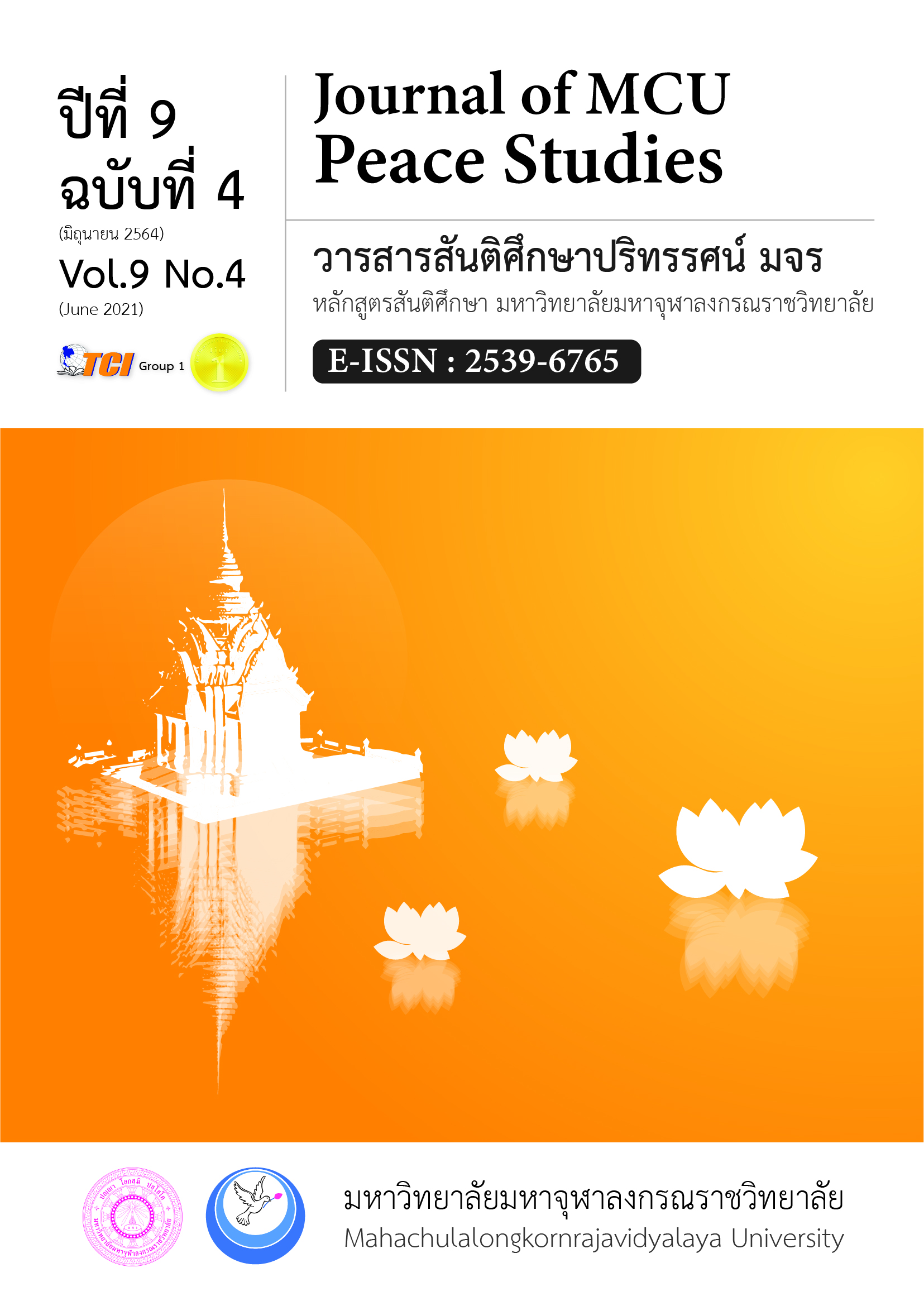ความโกรธและตัวตน: รูปแบบในการแสดงความโกรธ ของผู้ขับรถยนต์และการเกิดอุบัติเหตุทางถนนในกรุงเทพมหานคร
Main Article Content
บทคัดย่อ
บทความวิจัยฉบับนี้ มีวัตถุประสงค์เพื่อ 1) ศึกษาอารมณ์โกรธและการแสดงความโกรธของผู้ขับรถยนต์บนถนน 2) ตรวจสอบรูปแบบการแสดงความโกรธของผู้ขับรถยนต์ 3) ศึกษาความสัมพันธ์ระหว่างอารมณ์โกรธและการเกิดอุบัติเหตุบนถนน เป็นการวิจัยเชิงคุณภาพ กลุ่มตัวอย่างคัดเลือกแบบเฉพาะเจาะจงเป็นผู้ขับรถยนต์ในเขตพื้นที่กรุงเทพฯ จำนวน 20 คน โดยเครื่องมือที่ใช้เป็นแบบสอบถามกึ่งโครงสร้าง ในการสัมภาษณ์เชิงลึก สังเกตการณ์อย่างมีส่วนร่วม และสังเกตการณ์ผ่านกล้องบันทึกภาพในรถยนต์ ทำการวิเคราะห์ข้อมูลโดยการวิเคราะห์เนื้อหาด้วยการวิเคราะห์ความเชื่อมโยงระหว่างผู้ขับรถยนต์และบริบทต่างๆ ที่เกี่ยวข้องและเขียนบรรยายเชิงวิเคราะห์ ผลการวิจัยพบว่า 1) สาเหตุที่ผู้ขับรถยนต์โกรธเกิดจากการกระทำ และการโต้ตอบระหว่างกัน ผ่านฉากสถานการณ์ที่มีความเฉพาะเจาะจง 2) ปัจเจกบุคคลมีรูปแบบในการแสดงความโกรธแตกต่างกันไป บางคนไม่แสดงออก ในขณะที่บางคนแสดงออกมาชัดเจนด้วยความก้าวร้าว ซึ่งมีสาเหตุจากสถานการณ์และการไม่สามารถสื่อสารได้ทันที ทำให้ต้องประเมินผล ตีความ สรุปความหมายการกระทำของคู่กรณีผ่านตัวตนของบุคคลที่ประกอบสร้างขึ้นจากการให้นิยามคุณค่าต่อสิ่งต่างๆ 3) ความสัมพันธ์ระหว่างอารมณ์โกรธและ การเกิดอุบัติเหตุบนถนนมีความเชื่อมโยงกับพฤติกรรม เพราะความโกรธที่เกิดขึ้นได้หล่อหลอมและประกอบสร้างตัวตนใหม่ที่เพิ่มเติมจากตัวตนเดิม และนำมาสู่การกระทำ ผลักดันให้แสดงออกอย่างก้าวร้าวและรุนแรงขึ้นซึ่งจะแปรผันตามการตอบโต้ หรือปฏิกิริยาที่เกิดขึ้นของคู่กรณี รวมถึงมีระยะของความโกรธด้วย
Article Details
ทัศนะและความคิดเห็นที่ปรากฏในบทความในวารสาร ถือเป็นความรับผิดชอบของผู้เขียนบทความนั้น และไม่ถือเป็นทัศนะและความรับผิดชอบของกองบรรณาธิการ ยินยอมว่าบทความเป็นลิขสิทธิ์ของวารสาร
เอกสารอ้างอิง
American Automobile Association Foundation for Traffic Safety. (2016). Annual Traffic Safety Culture Index. Retrieved January 6, 2019, from https://aaafoundation.org/wpcontent/uploads/2017/11/2016TrafficSafetyCultureIndexReport.pdf.
Academic Center for Road Safety. (2015). Road Accident Information Management. The project to develop the operational capacity of the traffic police officers. Bangkok: Thai alphabet printing house. Retrieved January 10, 2019, from http://trsl.thairoads.org/FileUpLoad/1621/170201001621.pdf.
Averill, J. R. (1983). Studies on Anger and Aggression: Implications for Theories of Emotion. American Psychologist, 38(11), 1145–1160.
Britt, T.W., & Garrity, M.J. (2006). Attributions and Personality as Predictors of the Road Rage Response. The British Journal of Social Psychology, 45(1), 127-147.
Canary, D. J., Cupach, W. R., & Messman, S. J. (1995). Relationship conflict: Conflict in parentchild, friendship, and romantic relationships (Series on Close Relationships, Clyde and Susan Hendrick, Series Editors). Newbury Park, CA: Sage.
Crossman, A. (2013). Assessing a Situation, in Terms of Sociology. Definition of the situation. Retrieved January 8, 2019, from https://www.thoughtco.com/situation-definition3026244.
Deffenbacher, J. L. et al. (2003). Anger, aggression and risky behavior: A comparison of high and low anger drivers. Journal of Behavior Research and Therapy, 41(6), 701-718.
Dittman, M. (2005). The characteristics of angry drivers and what can be done to make the roads. American Psychological Association. Retrieved January 9, 2019, from https://www.apa.org/monitor/jun05/anger.
Edmondson, C.B., & Conger, J.C. (1996). A review of treatment efficacy for individuals with anger problems: conceptual, assessment and methodological issues. Clinical Psychology Review, 16, 251-275.
Froggatt, P., & Smiley, J.A. (1964). The concept of accident proneness: A Review. British journal of industrial medicine, 21(1), 1–12.
INRIX. (2017). Global Traffic Scorecard 2017. Retrieved October 2, 2017, from https://thestandard.co/inrix-global-traffic-scorecard-2017.
Jasper, J.M. (2014). Constructing Indignation: Anger Dynamics in Protest Movements. Emotion Review, 6(3), 208–213.
Katz, J. (1999). How Emotions Work. Chicago, IL: University of Chicago Press.
Kemper, T.D. (1978). Social Interaction Theory of Emotions. New York: Wiley.
Kemper, T.D. (1990). Social structure and testosterone: Explorations of the socio-bio-social chain. American Psychological Association. Retrieved January 10, 2019, from https://psycnet.apa.org/record/1990-98879-000
Mead, G.H. (1934). Mind, self and society [The Definitive Edition]. (Morris C.W. (Editor). Chicago: University of Chicago Press. (2015).
Office of information and communication technology, Royal Thai Police. (2016). Road traffic accident statistics for 2016. Bangkok. Retrieved February 10, 2019, from http://pitc.police.go.th/2014/.
Saxena, N. (2017). Analysis of Road Traffic Accident using Causation Theory with Traffic Safety Model and Measures. International Journal for Research in Applied Science & Engineering Technology, 5(8), 1263-1269.
Schieman, S. (1999). Age, Physical Impairment, and Symptoms of Anxiety: A Test of Mediating and Moderating Factors. Retrieved March 4, 2019, from https://doi.org/10.2190/P4EA-5CQ5-NMHD-30BX.
Simmel, G. (1903). The Metropolis and Mental Life. Translated from German by Wolff, K.H. ed. The Sociology of Georg Simmel. New York: Free Press.
Simmel, G., & Wolff K.H. (1950). The sociology of Georg Simmel. Glencoe, Illinois: Free Press.
Thoits, P. (1989). The sociology of emotion. Annual Review, 15, 317-342. Retrieved November 2, 2019, from https://www.annualreviews.org/doi/pdf/10.1146/annurev.so.15.080189.001533.


